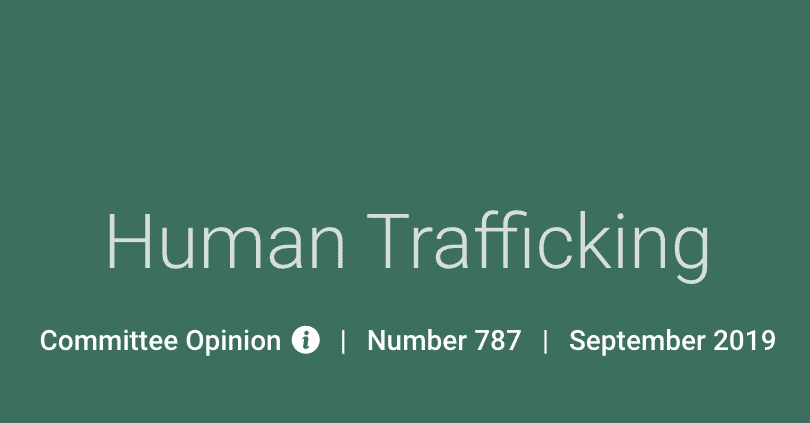
Human Trafficking
ABSTRACT: Human trafficking, or modern-day slavery, is a global problem with broad reach that is often underrecognized in the United States. Victims of trafficking have been found in a wide range of legal and illegal business settings, and this frequently hidden population is most often exploited in the commercial sex industry, agriculture, factories, hotels, restaurants, as domestic workers, and by marriage brokers and some adoption firms. Human trafficking disproportionately affects underserved women and children, with more than 70% of trafficking cases involving women and girls and more than 90% of victims trafficked into the sex industry. Obstetrician–gynecologists and other women’s health care providers are well-situated to identify and assist victims of human trafficking. Many trafficked individuals present to outpatient obstetrics and gynecology clinics, community health centers, family planning clinics, urgent care centers, and adolescent medicine clinics, and one half of all female victims of sex trafficking have visited the emergency department while involved in sex trafficking. Obstetrician–gynecologists and other women’s health care providers should be aware of human trafficking, recognize signs of human trafficking, and be prepared to assist patients who are victims or who have been victims of human trafficking. This Committee Opinion has been updated to include screening questions and indicators to identify victims of human trafficking, additional information regarding reporting obligations for suspected human trafficking, and additional resources for survivors of human trafficking.
Recommendations
The American College of Obstetricians and Gynecologists makes the following recommendations to improve awareness of the signs of human trafficking and to prepare obstetrician–gynecologists and other women’s health care providers to take action:
- Recognize indicators of human trafficking, such as patients with signs of abuse or neglect or those accompanied by an individual who does not let the patient speak for themselves, refuses to allow for privacy, or insists on interpreting for them in place of a professional.
- Become well-informed about common health care issues faced by victims of human trafficking, including sexually transmitted infections, substance use disorders, mental health problems, and physical trauma.
- Evaluate a patient’s medical and nonmedical needs while recognizing the importance of providing a safe and comfortable environment for the patient, using appropriate methods of communication, and acknowledging the dynamics involved in evaluating a patient who is subject to human trafficking.
- Be aware of the laws in your jurisdiction regarding reporting obligations for suspected human trafficking, with specific attention to mandatory reporting requirements for child abuse.
- Provide resources for survivors of human trafficking, including brochures, pamphlets, and pocket cards displayed in examination rooms, waiting rooms, or, more discretely, in bathrooms in addition to contact information for organizations and resources that can support survivors.
Read more here.
